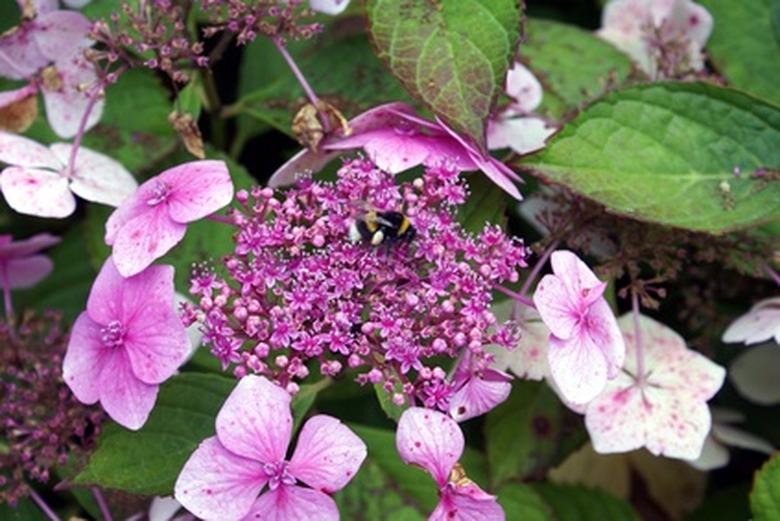Flowers Similar To Hydrangeas
Hydrangea shrubs provide large clustered flower heads beloved for garden design compositions and cut flowers. They take either of two flower head shapes: mophead or "snowball-like" and lacecap, which is a flattened cluster of tiny flowers surrounded by showy bracts that look like exploding fireworks. Plant other "hydrangea-like" shrubs in your landscape to trick people into thinking you are the only one in the neighborhood with early flowering and "eager" hydrangrea shrubs.
Chinese Snowball
Blooming much earlier than any hydrangea bush, Chinese snowball (Viburnum macrocephalum) blooms in early to mid-spring and is certain to make you think it's a white snowball hydrangea bush. Growing 6 to 20 feet tall depending on how cold your winter is, it is best cultivated in U.S. Department of Agriculture hardiness zones 6 through 9. The flowers are first apple green before becoming pure white.
Japanese Snowball
Blooming in mid-spring about the same time as rhododendrons and kerria, the Japanese snowball (Viburnum plicatum f. plicatum) is best grown in USDA hardiness zones 5 through 7, and through 8 and 9 on the American Pacific Coast. Growing 12 to 15 feet tall and wide with horizontally reaching branches, the flowers are first pale green and then flush white in handsome snowball-like clusters about the size of apples. Choose any of the smaller-growing cultivars if your garden is limited on space: Popcorn, Newport/Newzam and Leach's Compacta bloom white, while Mary Milton, Pink Sensation and Rosace flowers are pink to rose.
- Hydrangea shrubs provide large clustered flower heads beloved for garden design compositions and cut flowers.
- Blooming in mid-spring about the same time as rhododendrons and kerria, the Japanese snowball (Viburnum plicatum f. plicatum) is best grown in USDA hardiness zones 5 through 7, and through 8 and 9 on the American Pacific Coast.
Doublefile Viburnum
Practically a sibling to the Japanese snowball is the doublefile viburnum (Viburnum plicatum f. tomentosum), which produces white lacecap flowers and red-to-black berries by mid-summer. Flowering about 10 days earlier than the Japanese snowball, doublefile viburnum produces huge numbers of flat clusters of tiny fertile flowers surrounded by larger four-petaled sterile blossoms that look like butterflies. This shrub grows 8 to 10 feet tall and 9 to 12 feet wide, displaying wide-spreading tiered branches. Cultivars of doublefile viburnum include Cascade, Shasta, Lanarth and Summer Snowflake. Pink-flowering selections of merit are Pink Beauty and Molly Schroeder. Grow them in the same regions as the Japanese snowball.
Linden Viburnum
University of Georgia horticulture professor Michael Dirr simply says "Wow! Spectacular!" when mentioning the linden viburnum (Viburnum dilatatum). Dirr likely enjoys the berries more than the hydrangea-like clusters of white blossoms that occur in late spring. Grow this shrub in USDA hardiness zones 5 through 7, where it matures 8 to 10 feet tall and wide. Catskill, Erie and Onedia are cultivars.
- Practically a sibling to the Japanese snowball is the doublefile viburnum (Viburnum plicatum f. tomentosum), which produces white lacecap flowers and red-to-black berries by mid-summer.
- Cultivars of doublefile viburnum include Cascade, Shasta, Lanarth and Summer Snowflake.
European Cranberry Bush
Europeans call it the Guelder rose, but North Americans dub it the European cranberry bush (Viburnum opulus). Growing 10 to 15 feet tall and wide when mature, this shrub bears white flowers that resemble lacecap hydrangeas. Cranberry bush's flat flower clusters have tiny, white, fertile flowers surrounded by large white, five-petaled sterile blossoms. In mid to late spring the shrub is festooned in these large flower heads, followed by pretty red berries by late summer. Grow this shrub in USDA hardiness zones 4 through 7. Cultivars Roseum and Xanthocarpum both produce flower clusters that look like white snowballs.
References
- "Viburnums"; Michael A. Dirr; 2007
- University of Illinois Extension: Doublefile Viburnum
